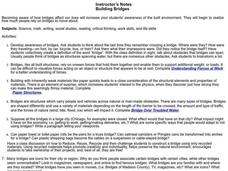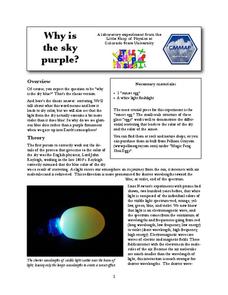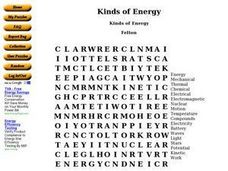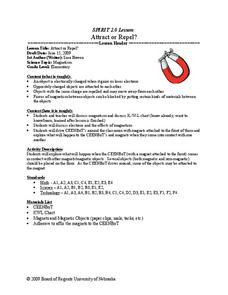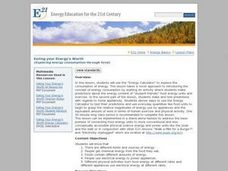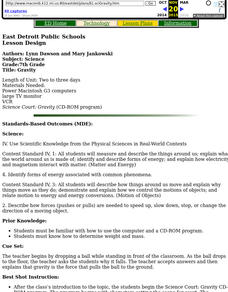Curated OER
Building Bridges
Provide a comprehensive exploration of bridges and civil engineering. First, learners discuss the different types of bridges. Then, they identify the characteristics of a suspension, beam, and arch type of bridge. In addition, they learn...
Colorado State University
Why Is the Sky Purple?
The color of the sky depends on the time of day. Young scholars experiment with scattering different wavelengths of light to recreate the color of the sky. They observe both the longer blue wavelengths and the shorter red and orange...
Curated OER
Ohm's Law
If your future physicists know how to construct simple circuits, include resistors, and use a multi-meter to measure voltage, then you might employ this instructional activity on Ohm's law. Each lab group investigates the...
Curated OER
Off the Grid
Learners examine the advantages and disadvantages of renewable and non renewable energy sources. In this engineering lesson students explain what it means for a house to be "off the grid".
Curated OER
Reversible and irreversible changes
Students define the words "reversible" and "irreversible." They complete a worksheet that shows a number of changes. Students must decide which are reversible and which are irreversible.
Curated OER
Kinds of Energy Word Search
In this energy word search puzzle, middle schoolers identify types of energy and related terms. They identify 18 words from a given list. An answer sheet is provided.
Curated OER
Magneto-hydrodynamic Drives
Students examine how electric and magnetic fields can be used to force water out of a chamber to move a vehicle forward.
Curated OER
Attract or Repel?
Students explain why some objects attract and some do not. In this physics activity, students investigate the magnetic properties of objects using CEENBoT. They give some important applications of magnets.
Curated OER
Wind Power! 2
Fourth graders explore how engineers transform wind energy into electrical energy by building their own miniature wind turbines and measuring the electrical current it produces. They see how design and position affect the electrical...
Curated OER
Wind Power
Fourth graders develop an understanding of how engineers use wind to generate electricity. They will build a model anemometer to better understand and measure wind speed. They discover that engineers design wind turbines that generate...
Curated OER
Lemon Batteries Revised
Fifth graders investigate how chemical energy in food and batteries is potential or stored energy. They discuss how batteries function, and create a class list of different forms of energy. Students then create a lemon battery that...
Curated OER
Creating a Simple Telegraph Machine
Students experiment and discuss circuits and how they work. In this science lesson, students construct a telegraph machine using cardboard, wires, battery, electric tape and masking tape. They investigate what happens as the circuits...
Curated OER
The Wonderful World of Waves (Wave Basics)
Learners define amplitude, wavelength, frequency, and period, calculate period given frequency, and calculate frequency given period, define crest and trough and locate both on diagram of wave, differentiate between latitudinal and...
Curated OER
The Historical Development of Magnetism
Students discuss the history and importance of magnets to the world. In this magnetism lesson, students write an essay of a world without magnets. Students may research addition information to add details about uses of magnets.
Curated OER
Introduction to the Periodic Table
In this periodic table worksheet, students will label the atomic number, atomic mass, element name, and element symbol for oxygen. Then students will determine the characteristics of the different groups of elements on the periodic table...
Curated OER
Maglev Trains
Young scholars explore how Maglev trains work. In this technology lesson, students discuss the pros and cons of Maglev compared to conventional trains. They build a simple Maglev train model.
Curated OER
Bermuda Triangle
Young scholars explore what the Bermuda triangle is and the theories as to why it is so mysterious. In this mystery lesson students read and discuss the history and the mystery behind the Bermuda Triangle.
Curated OER
Eating your Energy's Worth
Learners calculate the amount of electrical energy used in a week in food units. They create ways to reduce energy use. Students discuss the different forms and sources of energy. They discuss how people use electrical energy to power...
Curated OER
Powering a Green Earth
Pupils compare and contrast renewable and nonrenewable energy. In this environmental science lesson, students discuss the importance of going green. They identify the different components in a power grid system.
Curated OER
Circuit City
Fifth graders are introduced to the concept of circuits and how electricity works. In groups, they design their own subdivision with houses in which they have inside and outside light sources. To end the lesson, they make the circuits...
Curated OER
Global Warming – More or Less
Eighth graders identify the factors that contribute to global warming. In this earth science lesson, 8th graders evaluate the impact of global warming on the planet. They discuss their views within the group.
Curated OER
Gravity
Seventh graders progress through the Science Court: Gravity CD-ROM program. They read about and discuss how gravity was discovered. They complete review worksheets in preparation for the test.
Curated OER
Design Project: Stepper Motor Driver
In this electronics worksheet, students design and build a stepper motor drive circuit. They answer 1 short answer question about the design.
Curated OER
Circuit Diagrams
In this circuit diagram worksheet, students study the various symbols for the circuit symbols and how to make a circuit diagram. Students then label the diagram with the 5 symbols.


